In the future教案
- 格式:docx
- 大小:13.72 KB
- 文档页数:4
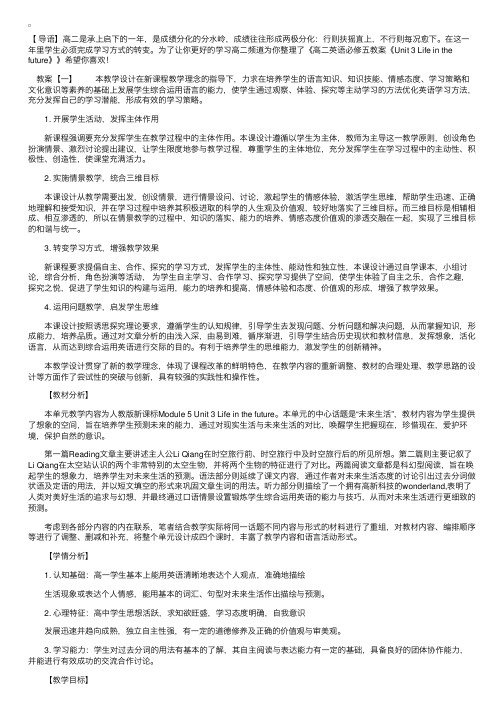
【导语】⾼⼆是承上启下的⼀年,是成绩分化的分⽔岭,成绩往往形成两极分化:⾏则扶摇直上,不⾏则每况愈下。
在这⼀年⾥学⽣必须完成学习⽅式的转变。
为了让你更好的学习⾼⼆频道为你整理了《⾼⼆英语必修五教案《Unit 3 Life in the future》》希望你喜欢! 教案【⼀】 本教学设计在新课程教学理念的指导下,⼒求在培养学⽣的语⾔知识、知识技能、情感态度、学习策略和⽂化意识等素养的基础上发展学⽣综合运⽤语⾔的能⼒,使学⽣通过观察、体验、探究等主动学习的⽅法优化英语学习⽅法,充分发挥⾃⼰的学习潜能,形成有效的学习策略。
1. 开展学⽣活动,发挥主体作⽤ 新课程强调要充分发挥学⽣在教学过程中的主体作⽤。
本课设计遵循以学⽣为主体,教师为主导这⼀教学原则,创设⾓⾊扮演情景、激烈讨论提出建议,让学⽣限度地参与教学过程,尊重学⽣的主体地位,充分发挥学⽣在学习过程中的主动性、积极性、创造性,使课堂充满活⼒。
2. 实施情景教学,统合三维⽬标 本课设计从教学需要出发,创设情景,进⾏情景设问、讨论,激起学⽣的情感体验,激活学⽣思维,帮助学⽣迅速、正确地理解和接受知识,并在学习过程中培养其积极进取的科学的⼈⽣观及价值观,较好地落实了三维⽬标。
⽽三维⽬标是相辅相成、相互渗透的,所以在情景教学的过程中,知识的落实、能⼒的培养、情感态度价值观的渗透交融在⼀起,实现了三维⽬标的和谐与统⼀。
3. 转变学习⽅式,增强教学效果 新课程要求提倡⾃主、合作、探究的学习⽅式,发挥学⽣的主体性、能动性和独⽴性,本课设计通过⾃学课本,⼩组讨论,综合分析,⾓⾊扮演等活动,为学⽣⾃主学习、合作学习、探究学习提供了空间,使学⽣体验了⾃主之乐,合作之趣,探究之悦,促进了学⽣知识的构建与运⽤,能⼒的培养和提⾼,情感体验和态度、价值观的形成,增强了教学效果。
4. 运⽤问题教学,启发学⽣思维 本课设计按照诱思探究理论要求,遵循学⽣的认知规律,引导学⽣去发现问题、分析问题和解决问题,从⽽掌握知识,形成能⼒,培养品质。
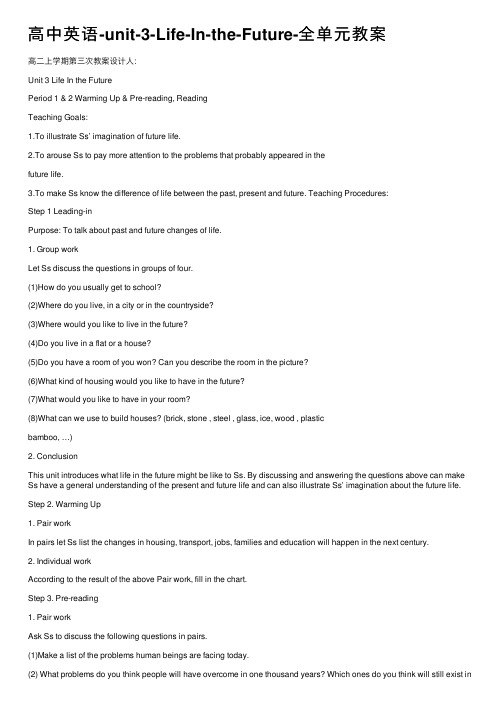
⾼中英语-unit-3-Life-In-the-Future-全单元教案⾼⼆上学期第三次教案设计⼈:Unit 3 Life In the FuturePeriod 1 & 2 Warming Up & Pre-reading, ReadingTeaching Goals:1.To illustrate Ss’ imagination of future life.2.To arouse Ss to pay more attention to the problems that probably appeared in thefuture life.3.To make Ss know the difference of life between the past, present and future. Teaching Procedures:Step 1 Leading-inPurpose: To talk about past and future changes of life.1. Group workLet Ss discuss the questions in groups of four.(1)How do you usually get to school?(2)Where do you live, in a city or in the countryside?(3)Where would you like to live in the future?(4)Do you live in a flat or a house?(5)Do you have a room of you won? Can you describe the room in the picture?(6)What kind of housing would you like to have in the future?(7)What would you like to have in your room?(8)What can we use to build houses? (brick, stone , steel , glass, ice, wood , plasticbamboo, …)2. ConclusionThis unit introduces what life in the future might be like to Ss. By discussing and answering the questions above can make Ss have a general understanding of the present and future life and can also illustrate Ss’ imagination about the future life. Step 2. Warming Up1. Pair workIn pairs let Ss list the changes in housing, transport, jobs, families and education will happen in the next century.2. Individual workAccording to the result of the above Pair work, fill in the chart.Step 3. Pre-reading1. Pair workAsk Ss to discuss the following questions in pairs.(1)Make a list of the problems human beings are facing today.(2) What problems do you think people will have overcome in one thousand years? Which ones do you think will still exist inAD 3008?Suggested Answers:①The first problem I would like to point out is the decline of morality.(道德沦丧)②The second problem is the racial bias problem. (种族歧视)③The third problem , which is a most serious problem , is the rapid depletion of resources on the Earth. (资源匮乏)④Now I come to the fourth problem, the problem of the large gap between the poor and the rich . (贫富悬殊)⑤The fifth problem is the pollution problem.(环境恶化)⑥Now I would like to talk about the sixth problem, the expensive arms race problem. (军备竞争)。
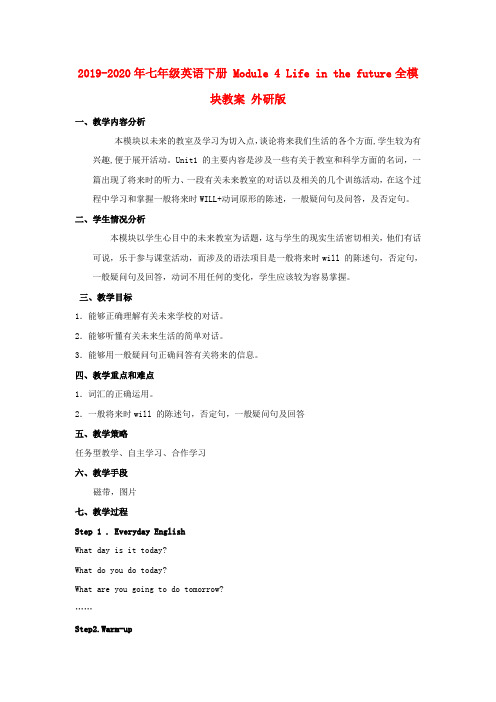
2019-2020年七年级英语下册 Module 4 Life in the future全模块教案外研版一、教学内容分析本模块以未来的教室及学习为切入点,谈论将来我们生活的各个方面,学生较为有兴趣,便于展开活动。
Unit1的主要内容是涉及一些有关于教室和科学方面的名词,一篇出现了将来时的听力、一段有关未来教室的对话以及相关的几个训练活动,在这个过程中学习和掌握一般将来时WILL+动词原形的陈述,一般疑问句及问答,及否定句。
二、学生情况分析本模块以学生心目中的未来教室为话题,这与学生的现实生活密切相关,他们有话可说,乐于参与课堂活动,而涉及的语法项目是一般将来时will 的陈述句,否定句,一般疑问句及回答,动词不用任何的变化,学生应该较为容易掌握。
三、教学目标1.能够正确理解有关未来学校的对话。
2.能够听懂有关未来生活的简单对话。
3.能够用一般疑问句正确问答有关将来的信息。
四、教学重点和难点1.词汇的正确运用。
2.一般将来时will 的陈述句,否定句,一般疑问句及回答五、教学策略任务型教学、自主学习、合作学习六、教学手段磁带,图片七、教学过程Step 1 . Everyday EnglishWhat day is it today?What do you do today?What are you going to do tomorrow?……Step2.Warm-upT: What will you do at this weekend?S: I will do my homework at this weekend..T: Will you play the piano this afternoon?S: Yes, I will /No, I will not.………Like this, ask the students to work in pairs to review the future tense.Step2. PresentationT: What will you do at this weekend?Help the students answer: I will play games at this weekend.(用be going to+do引出will+do,使同学们在很自然的复习语境中导入到新课)Ask the students to work in pairs to practice will+do.Step3.Vocabulary(1) Use the pictures to teach the new words :cable, , cell phone, , paper, ruler, satellite TV.(2)guessing games :What do you use to learn math and science ? calculatorWhat do I use to teach English? chalk(3)Let students repeat the words loudly.(创设情景教单词,使学生自然地掌握了单词的读音和用法。

UNIT 2LOOKING INTO THE FUTURE主题语境人与社会——未来生活背景导入:5G作为经济社会数字化转型的关键使能器,通过与大数据、人工智能、云计算等技术的交叉融合,赋能制造业转型升级和优化发展,5G技术以及未来5G对我们日常生活的影响。
Forging a 5G futureThe future in scifi movies seems so close, yet so far away. Delightfully, 5G technology makes that future look easily achievable①. Schools, hospitals, transportation, factories—even our homes will soon use this powerful wireless network. Last year, China started testing 5G mobilenetworks in its several cities. So what is 5G? It's the latest generation of cellular (蜂窝状的)network technology. It is faster and more stable than 4G, the previous generation.5G's benefits mainly come from speed and connectivity②. The advantage of higher speeds is obvious. People will be able to use the Internet at a much greater speed than before. Imagine being able to download an entire movie in just a few seconds! That's how fast 5G will be.With 5G, people can conveniently solve many problems.For example, one of the biggest problems with developing driverless cars is the delay between sending a signal and receiving it. Driverless cars③ must be able to react instantly to sudden changes in their environment, such as a dog running across the road.This will require these cars to send and receive huge amounts of data within milliseconds④. Such speed helps other technologies, too. It will also allow doctors toperform operations remotely, using robots. The robots will respond more quickly to the doctors' movements.So what about 5G's connectivity?We may develop “smart” environments with it.Imaginehaving a smart home that automatically⑤ turns the lights on when you open your front door.“New things become possible when you can move information at a massive scale⑥,”Gordon Smith, CEO of telecom equipment reseller Sagent, told The Telegraph.“5G becomes the great enabler.”No matter where it is implemented, it looks like 5G will bring us a more exciting and convenient future.①achievable adj. 可完成的;可有成就的②connectivity n. 连通(性), 联结(度)③driverless cars 无人驾驶汽车④milliseconds n.[计量]毫秒⑤automatically ad v. 无意识地;自动地⑥at a massive scale 大规模地[随手记]Section ⅠReading and Thinking每/日/金/句:The greatest advances in science are brought about by a new and bold imagination.科学最伟大的进步来源于崭新而大胆的想象力。
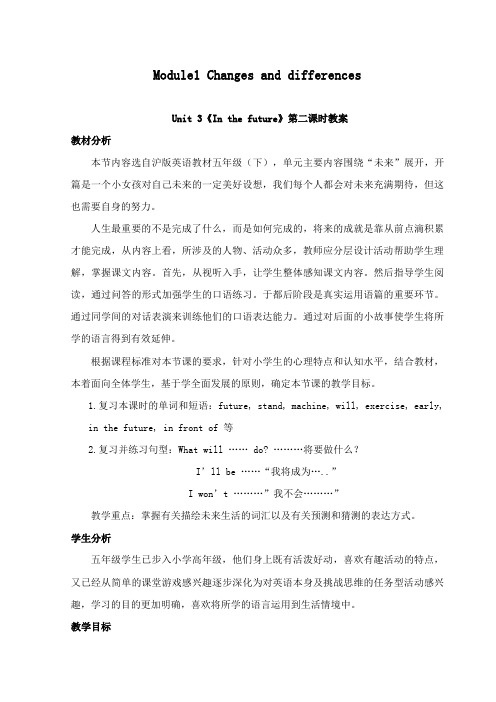
Module1 Changes and differencesUnit 3《In the future》第二课时教案教材分析本节内容选自沪版英语教材五年级(下),单元主要内容围绕“未来”展开,开篇是一个小女孩对自己未来的一定美好设想,我们每个人都会对未来充满期待,但这也需要自身的努力。
人生最重要的不是完成了什么,而是如何完成的,将来的成就是靠从前点滴积累才能完成,从内容上看,所涉及的人物、活动众多,教师应分层设计活动帮助学生理解,掌握课文内容。
首先,从视听入手,让学生整体感知课文内容。
然后指导学生阅读,通过问答的形式加强学生的口语练习。
于都后阶段是真实运用语篇的重要环节。
通过同学间的对话表演来训练他们的口语表达能力。
通过对后面的小故事使学生将所学的语言得到有效延伸。
根据课程标准对本节课的要求,针对小学生的心理特点和认知水平,结合教材,本着面向全体学生,基于学全面发展的原则,确定本节课的教学目标。
1.复习本课时的单词和短语:future, stand, machine, will, exercise, early,in the future, in front of 等2.复习并练习句型:What will …… do? ………将要做什么?I’ll be ……“我将成为…..”I won’t ………”我不会………”教学重点:掌握有关描绘未来生活的词汇以及有关预测和猜测的表达方式。
学生分析五年级学生已步入小学高年级,他们身上既有活泼好动,喜欢有趣活动的特点,又已经从简单的课堂游戏感兴趣逐步深化为对英语本身及挑战思维的任务型活动感兴趣,学习的目的更加明确,喜欢将所学的语言运用到生活情境中。
教学目标Knowledge objectives知识与技能使学生运用所学知识把本节课的生活用语能够运用到实践当中,并且也能加强口语的练习。
过程与方法通过网上资源等搜集有关未来的一些资料,培养学生利用学习资源的策略。
着重培养学生学习运用词汇学习中的猜词策略,激发学生想象力,奔向未来。
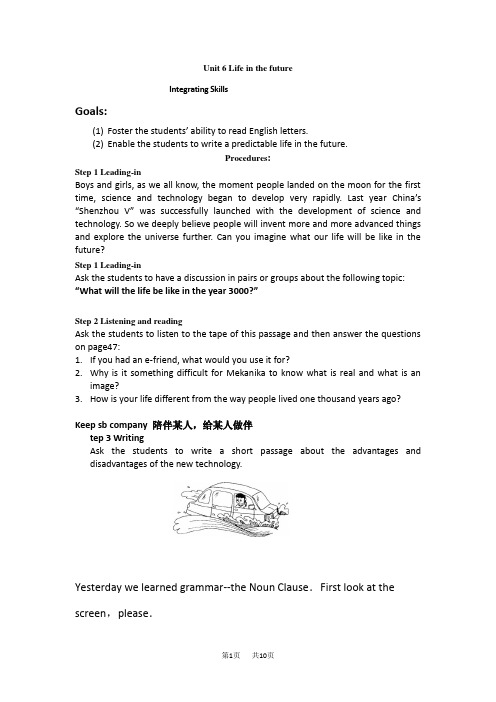
Unit 6 Life in the futureIntegrating SkillsGoals:(1)Foster the students’ ability to read English letters.(2)Enable the students to write a predictable life in the future.Procedures:Step 1 Leading-inBoys and girls, as we all know, the moment people landed on the moon for the first time, science and technology began to develop very rapidly. Last year China’s “Shenzhou V” was successfully launched with the development of science and technology. So we deeply believe people will invent more and more advanced things and explore the universe further. Can you imagine what our life will be like in the future?Step 1 Leading-inAsk the students to have a discussion in pairs or groups about the following topic:“What will the life be like in the year 3000?”Step 2 Listening and readingAsk the students to listen to the tape of this passage and then answer the questions on page47:1.If you had an e-friend, what would you use it for?2.Why is it something difficult for Mekanika to know what is real and what is animage?3.How is your life different from the way people lived one thousand years ago? Keep sb company 陪伴某人,给某人做伴tep 3 WritingAsk the students to write a short passage about the advantages and disadvantages of the new technology.Yesterday we learned grammar--the Noun Clause.First look at the screen,please.(Show the following on the screen.)1.What life will be 1ike in the future is the topic for today’s class discussion.2.Can you imagine what life will be like in the future?3.One of the questions that few people can give answer to is what life will belike in the future.T:Study the sentences and find out what kind of Noun Clause the underlined part in each sentence is.(The students prepare for a couple of minutes.Then the teacher may ask some student to say their answers.)Suggested answers:1.Subject Clause2.Object Clause3.Predicative ClauseT:Good.But generally speaking,it is hard for you to choose connectiyes in- troducing the Noun Clause.Only when you know the functions of the connectives can you use the Noun Clause as the Subject,Object,Predi-cative and Appositive freely.Now let’s do some exercises to consolidate what you have learnt.(Show the following on the screen.)Fill in the blanks with suitable connec-tives.1._______composition is the best is known to us a11.2.He wondered________he was not al-lowed to go out alone.3.______is to take Li Ming’s place is being dis cussed.4.I got very angry with______he said.5.My idea is_________we should ger more people to finish the work.6.I wonder_________it is true or not.7.The problem is___________we could help smokers kick their habit.8.The news__________we had won in the match excited all.9.We have no idea_________she was born.10.That’s________we decided to put the meeting off.Suggested answers:1.Whose 2.why 3.Who 4.what 5.that 6.whether 7.how 8.that 9.when/where lO.whyT:In this unit,we’ve also learned some u seful expressions.Do you remember them?Now let’s do an exercise to re-vise them.please look at the screen.(Show the following on the screen.)Complete the sentences,using the ex-pressions learnt in this unit.1._______his work has been good,but this essay is terrible.2.You should________your friend by let-ter.3.Please_________what I am saying.4.He always keeps several baskets of apples________.5.The misprint________great confusion.6.He_______her before she vanished(消失)into the crowd.7.His dream of being a famous singer________at last.Suggested answers:1.In general 2.keep in touch with3.pay attention to 4.in store5.led to 6.caught a glimpse of7.came trueT:In this unit,we’ve also read a passage about life in the fu ture.Now pleasethink out some words you can use to describe life in the future.(After a while,ask some students to say out the words.)Step Ⅲ Reading and WritingT:OK.As we know,people’s life hasbeen changing.It’s getting better and better.What do you think life in the 3lstcentury will be like?will it be the same as that today?Ss:No.We think life in the 3lst century will be very different from that in this century.We’ll live more easily than today.We’ll have a machine do what we want them to.The only thing we need to do is to press the buttons on the computer.T:OK.Thank you.Today we’re going to read a letter about the waypeople willlive more than one thousand years lat-er and we can know what the life in the 3lst century will be like.First let me explain some phrases to you:keep sb.Company,a bit and clear up.(Show the following on the screen.)1.keep sb.company:remain with sb.so that he is not alone.e.g.He stayed at home to keep his wife company.I’ll stay here and keep you company.2.a bit:rathere.g.He is feeling a bit tired.The book costs a bit much.3.clear up:put in order/make sth.Tidye.g.Clear up your desk before you leave the classroom.Would you please clear up the cup-board?(Bb:keep sb.Company,a bit,clear up)T:Now open your books at Page 47.Look at Reading and Writing.Here is a letter from Mekanika.Now you’re given four minutes to read it.Then answer some questions under the letter.(The students begin to read.After a while.teacher checks their compre-hension.)T:Who’d like to tell me what you would use an e-friend for,if you had one?(One students stands up.)S:Let me try.If I had an e-friend.I would let him help me with what I couldn't do,keep me company,talk with me and help me with my homework.(Another student begins to give the answer.)S:I think I would have the e-friend help me take notes when I was listening to a lecture and play chess with me.Fur-thermor,I would let my e-friend help me if I was in trouble.T:Thank you.Now the second question:Why is it sometimes difficult for Mek-anika to know what is real and what is an image?Any volunteer?S:Because the world and people are imi-tated so well that we can see them,hear them,touch them,talk to them and feel them.They are just like the real world and real people.T:OK.The last question:How is our 1ife different from the way people lived one thousand years ago?S:Now life is much easier and more con-venient than in the past.We can keep in touch with each other by cellphone or by computer insteadof by writing letters.S:We can travel by car instead of on foot.We can buy things on the Inter-net.We can also get the latest infor-mation by surfing the Internet.…Step Ⅳ Listening and Reading AloudT:Now let’s listen to the tape.When I play it for the first time,just listen carefully.When I play it for the second time,please listen and repeat.Then read the passage aloud.Pay attention to your intonation.Are you clear?S:Yes.(Play the tape for the students to lis-ten.Then when the students read the passage.the teacher goes among them and corrects their mistakes in pronun-ciation,intonation and stress.)Step V WritingT:We have known what the life will be in the year 3044.Imagine that you have come back from a trip to the future.You visited the year 4367 and you saw a wonderful invention called a Mogray.Now work with your partner and decide what a Mogray is,what it looks like and what it is used for.(Teacher asks the students to discuss the questions.And then collect theiranswers.After that,the teacher says the following.)T:Now you know what it is like.Please write a paragraph about what a Mogray is.Before writing,you have to complete the outline on the screen.(Show the following on the screen.)(Teacher asks the students to write the outline in their exercise books.Students may have various answers.)T:OK.You have finished your outline.Please use it to write your paragraph.(Teacher may let the students hand them in after class,if time is limited.)One possible version:Life in the year 4367 is quite differ-ent from life in the 21st century.We willstill do many things we do today,but we do them differently.For example,we canuse a Mogary to help us.A Mogary is an intelligent robot,which looks exactly like a human being.It can be used in many fields.such as at home,in the factory or in nature.The Mogray can be easily and con-veniently used at home.If you want to travel,you can turn it into all kinds of transport that you like,such as a plane,a car or a train,which use the solar energy without pollution.When it is too cold ortoo hot,the head of the Mogray can be used as an air—conditioner,which can keep a proper temperature.There are all kinds of recipes in its head.It can cook all kinds of healthy and delicious food for yoi if you press the buttons on it.When you are bored,it can read some books for you,which are stored in its brain.It can also play chess with you or communicate with you.It has thoughts similar to yours,Your life will be rich and colorful with a Mogray companying you.It can be used in many fields.In a word,the earth will become even more beautiful with the help of it.Step Ⅵ Summary and HomeworkT:Today,we’ve learned a passage about the life in the year 3044.At the same time,we wrote a passage about the life in the year 4367.What’s more,we’ve revised the Noun Clause and the useful expressions in this unit.such as in general,keep in touch with,in store…(Write them on the blackboard.After class,you should master them further by revising what we’ve learnt in this unit.Don’t forget to prepare for the next unit.That’s all for today.Class is over.)Step Ⅶ The Design of the Writing on the BlackboardUnit 6 Life in the futureThe Fourth PeriodUseful expressions:keep sb.company a bit clear up in general keep in touch with in store pay attention to lead to catch a glimpse of come true。
英语:Unit3《Life in the future》教案(1)(新人教版必修5)Warming-up and ReadingTeaching Goals:1.Learn some new words and expressions.2.Improve the Ss’reading skills.3.To illustrate Ss’ imagination of future life4.Know the more advanced forms of transport in AD 3005 andthe advantages and problems of life in the future.Teaching Methods:1.Inductive method2.Pair work and group work3.Illustration4.Deductive MethodTeaching Procedures:Step 1 Greetings and Lead-in1.The teacher can start with daily greetings and try to lead in some words in this unit.Q1: Where do you come from? Do you live in the downtown or in the countryside?Is it a suitable location for people to live in?What is it made of? (brick, stone, steel, glass, wood, plastic, bamboo, mud…).Q2: No matter where you live, I am wondering how do you usually go to school? (by bike, by car, by bus…)Bikes, cars, buses and so on can be used to carry people or things from one place toanother place, and they are called vehicles.Q3:What other vehicles do you know?carriage, ambulance, jeep, airbus, train, truck, motorcycle, fire engine, …Q4:What means of transport do you know?Car, bicycle, motorcycle, train, plane, Space craftQ5:Imagine what the future means of transport will be like?2. ConclusionThis unit introduces what life in the future might be like to Ss. By discussing and answering the questions above can make Ss have a general understanding of the present and future life and can also illustrate Ss’ imagination about the future life.【设计说明】由日常问候开启话题,通过提问学生家乡情况导入城镇生活,引出不同的建筑材料及交通工具中的生词;然后总结交通工具的种类来预测未来的交通方式,从而导入课文。
【沪教版】五年级英语(三起)下册教学案Module Unit 3 In the future第一课时教学目标:1、通过Listen and say中的关于Kitty未来情况的动短文,帮助学生掌握本单元的核心句型。
2、通过look and learn栏目,帮助学生学习表示日常行为动作的动词短语。
教学重、难点1、能掌握单词future, stand, machine, will, in the future,2、会运用句型I will to be a teacher. I won’t wear glasses.教学方法:任务教学法、情景教学法。
教学过程:第一次备课第二次备课Pre-task preparations1、学生观看屏幕上快速呈现的人物图片,说出人物职业,以复习学过的关于职业的单词。
T:(show a picture of a doctor) Who’s she?Ss:A doctor.T:(show a picture of a driver) Who’s he?Ss:A driver.…然后就不同职业提问,让学生回答问题,为下面的新课学习和表达打下基础。
T: What can a doctor do?S1: A doctor can help sick people.While-task procedures1、出示年历并与学生问答,帮助学生展开合理的想象,进入所示情景中。
T:Look at the calendar. Which year is it now?Ss:It’s the year…T: (show a new calendar) Look. Which year is it now?Ss: It’s the year…...接着,学生根据教师口中的单词卡片,学习单词future.T:(show the flashcard for future) In 15 years, what will happen to you? It’s the future. Future, f-u-t-u-r-e, future.Ss: Future, f-u-t-u-r-e, future.T: (write in the future on the blackboard) Today we’ll talk about your future.然后,学生根据教师黑板上出示的句型,学习单词will和句型I will be…I will…T: In the future, what will you be? What will you do? In 15 years, I’ll be … years old. I’ll still work in the school. My son will be 21 years old. He’ll…2、学生看Listen and say的组图1,在教师的帮助下理解图意。
Unit 3 Life in the futureⅢ. 教材分析与教材重组1. 教材分析本单元以“Life in the future”为中心话题,旨在通过本单元的学习,让学生大胆发挥想象,对人类今后的生活环境,生活方式进行猜测,并在此基础上,对人类的种种活动进行反思,提倡环保生活意识。
同时让学生学会过去分词作定语和作状语的不同用法。
最后让学生将本单元所讨论的话题和推测手法相结合,学习怎样写report。
1.1 Warming Up 部分利用一个关于“住”和“行”的对比研究表格引导学生回顾过去,认识现在和展望未来。
通过这一活动,引发学生对过去,现在和未来的思考,使学生对将要阅读的文章有个知识准备。
1.2 Pre-reading 部分让学生充分运用发散思维,先列举当今世界人类面临的一些突出问题,然后要求学生思考为什么会产生这些问题,这些问题中哪些在未来社会仍然可能存在,哪些将会被克服,哪些将会恶化。
为下面的阅读做了铺垫。
1.3 Reading 部分通过一封发自未来的电子邮件,讲述了作者Li Qiang怎样安全到达“未来世界”,他对“未来世界”的印象,以及“未来世界”的日常生活方式和交通工具情况。
阅读时要把重点放在“未来世界”生活与当今生活的不同点上。
1.4 Comprehending 部分设计了三个教学活动来加深学生对Reading部分的理解。
第一个活动要求学生通过阅读找出“未来世界”在以下几个方面的变化:跨时空旅行,交通,住房,城镇环境和空气质量。
接着让学生在此基础上得出自己的结论,哪些变化好,哪些变化不好,并说明理由。
第二个活动要求学生通过阅读来判断Li Qiang对“未来世界”的态度是乐观的还是悲观的。
学生要在文中找出支持自己观点的论据,尽可能说服别人。
第三个活动让学生想象一下Li Qiang 将会去参加哪些活动。
这样既鼓励学生展开丰富的想象,又为Using Language 部分的语篇学习做了铺垫。